Redheads inspire artists for many centuries, but some of them were particularly attracted to this less common hair color which supposedly posses all kinds of magical powers. This page is dedicated to the most famous paintings of redheads , arranged by the most exposed painters and with several popular sub-themes in the 'redhead genre'.
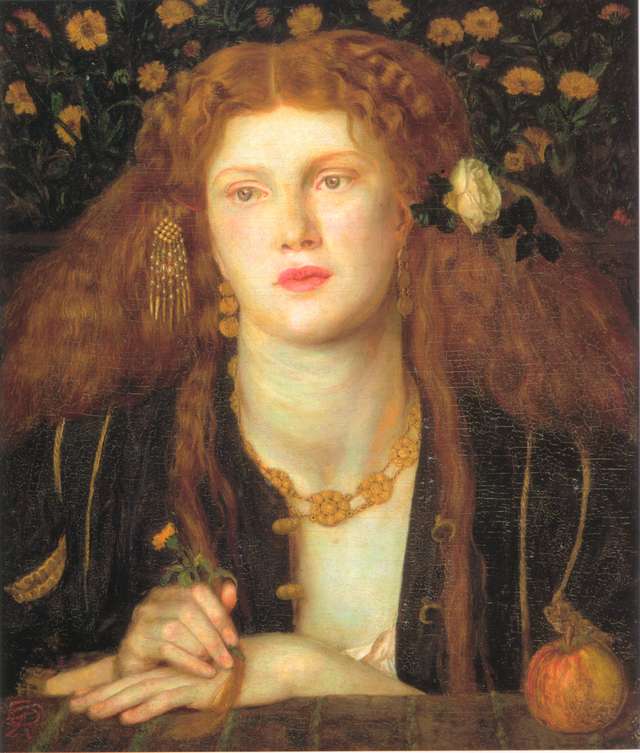
Dante Gabriel Rossetti (1828-1882)
Rossetti was a prolific painter, illustrator, poet and translator who is best known as the founder of very influential Pre-Raphaelit Brotherhood. His style has certain charm of Medieval Era, but in our case we'll focus only on his love for color red and redheads in particular.
Rossetti's models were relatively similar to each other, all beautiful, young, and with hair in striking contrast with their fair skin. They were not always redheads, yet the paintings with redheaded women are by far his most known today. Dante Gabriel Rossetti was a very passionate man, who was often romantically involved with his models. Fanny Cornforth (1835-1909,on the picture above) is one of them.
Alexa Wilding (1847-1884) is a notable exception to that rule. As far is we can find, there was never any intimate connection between her and the famous artist, yet she posed for him more than any other model. On the painting below we can see her as The Blessed Damozel.
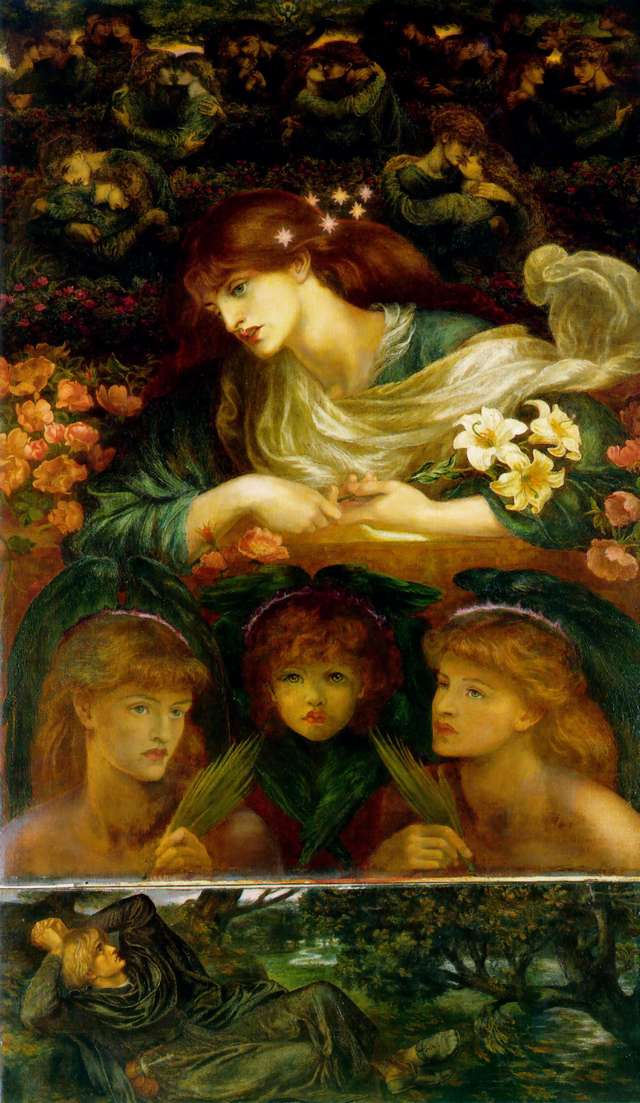
Elizabeth (Lizzie) Siddal is a completely different story. She was Rossetti's wife, who died in 1862. Next painting is a fusion of Rossetti's interpretation of Dante Aleghieri's Beatrice and his own love (Rossetti translated Dante's poems soon after the Lizzie's death). The original has a white poppy as a symbol of death and a red bird as a symbol of love in the background. Several replicas were made with the same theme, but some changes in the background etc., some done by Rossetti himself, some finished by other respected artists.
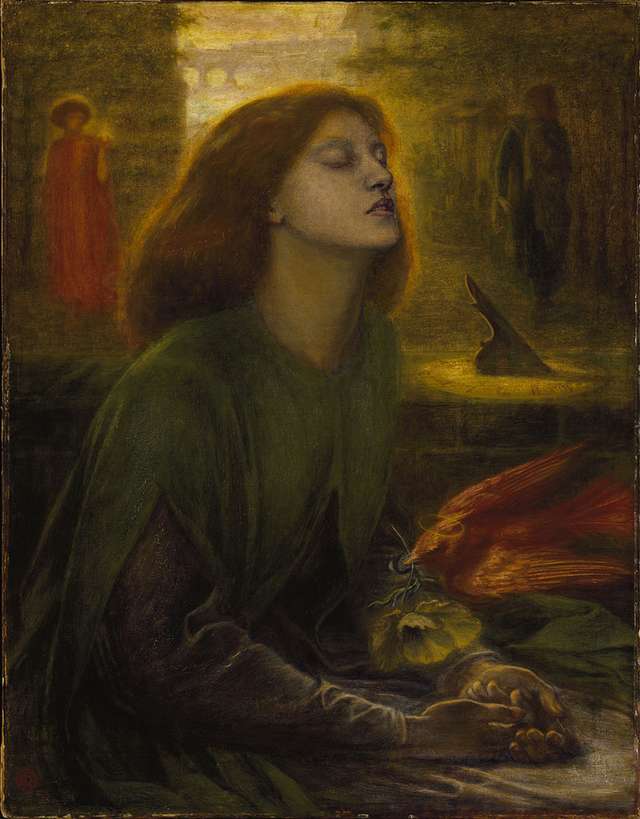
We continue with the exploration of the Rossetti's world of redheds. Jane Morris (1839-1914, born Burden) was a beautiful girl who inspired William Morris, Dante Gabriel Rossetti and Wilfried Blunt. She was the model for the first two and a muse to all of them. Her sensational beauty and inborn intelligence helped her to promote herself from the lowest class into high society, where one of her nicknames became Queenly.

The last example of Rossetti's fondness of redheads is Marie Spartali Stillman (1844-1927), an accomplished painter herself, who modeled for him on several occasions, at least once together with her husband William J. Stillman, another painter, who was also a journalist. The title of the next painting is A Vision of Fiammetta.

John Everett Millais (1829-1896)
Millais was a child prodigy (he became a student at the Royal Academy Schools at the tender age of eleven) who co-founded Pre-Rafaelite Brotherhood with aforementioned Rossetti. While his style significantly changed in 1850s, his affection to redheads remained a constant. Just like at Rossetti's works, models had ahuge influence on his private life and creation.
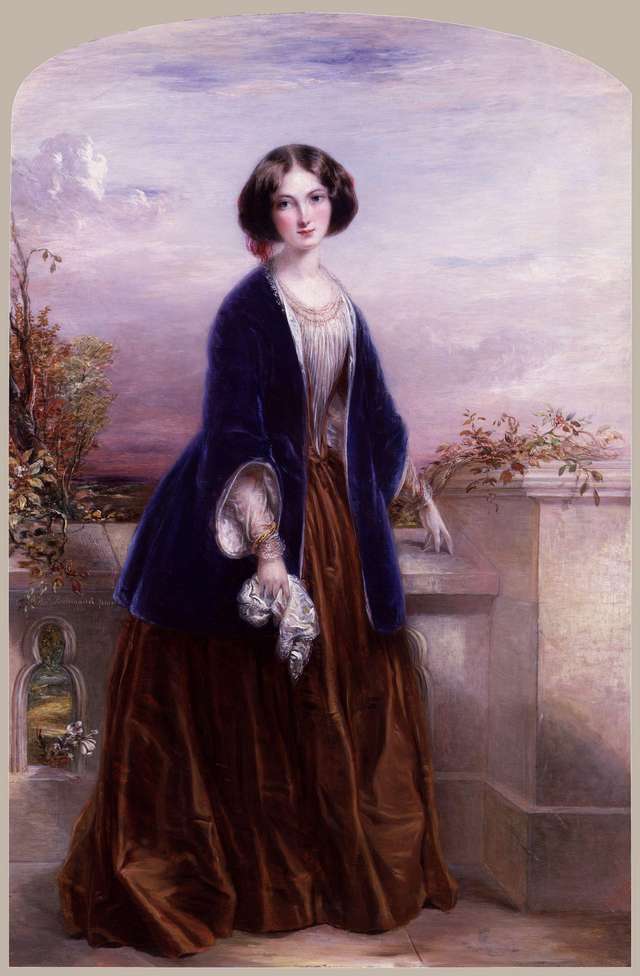
This is Euphemia Chalmers Gray (1828-1897), who was introduced to Millais as a wife of extremely important critic John Ruskin. After a few years of marriage her family aknowledged their marriage was never consummated and filed for annulment. Effie, as she was called for almost all her life, became Millais' model before that and used her influence on Ruskin even after she remarried, this time for Millais. On the painting above we can see her through the eyes of Thomas Richmond.
Thomas Richmond was well-known for his too idealised portraits and Effie said she looks lika a doll on this painting, so it's only fair to show her in the way her second husband and eventually father of her eight kids, Millais, saw Effie.
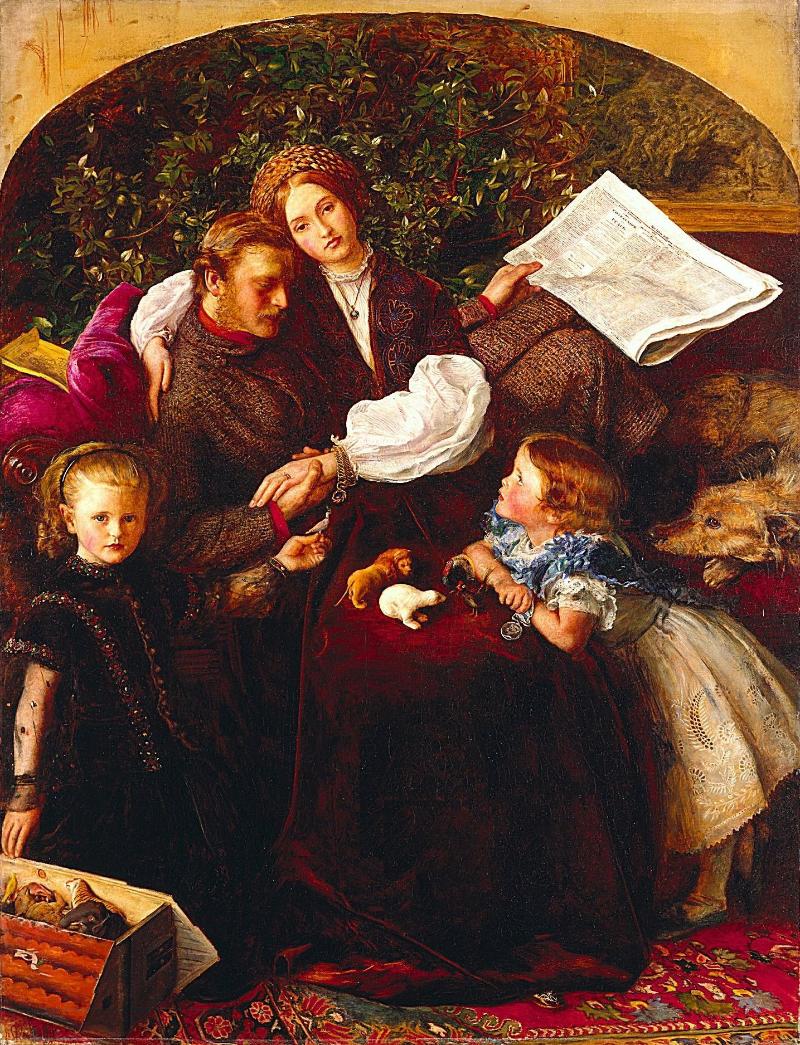
Millais' original idea was a critical depiction of then usual situation in the British Army, where officers were allowed to go home for 'urgent family issues', while ordinary soldiers stayed in battle trenches. The Crimean War ended before he finished the work and Millais changed it into the scene where awounded officer recovers in the family circle while the peace is proclaimed. The central figure of the painting is of course Effie.

Sophie Gray (1843-1882, above) was Effie's younger sister. Despite the age gap of 15 years they were close friends and Sophie played an important role in the annulment of her older sister's marriage with Ruskin. Sophie also became very close with Millais, what eventually led to numerous speculations about their relationship.
Sophie later married a successful businessman, gave birth to one daughter , developed a mental illness and died presumably from anorexia. Her beauty and internal demons were probably best to to Millais, who used her as a model on several occasions until Effie, aware of their growing mutual fondness, limited their companionship.

While oil painting above didn't accomplish too much of a succes when it was made, it now belong among most famous works in the world. It is exhibited in Tate Gallery in London and has a market value around 50 million dollars. The model in the picture is already mentioned Lizzie siddal, Rossetti's first wife. The scene depicts Ophelia, Shakespeare's character from Hamlet, singing just before drowns.
The very same theme inspired hundreds of artists in different media and it seems majority of painters accepted the idea of Ophelia as a reheaded woman. The artists in the gallery below are (from left to right): Thomas Francis Dicksee (1819-1895), John William Waterhouse (1849-1917) and Arthur Hughes (1832-1915).
Paintings of Ophelia
Millais' paintings of red haired woman are not finished yet. He have found another beautiful fictional character in Sahkespeare's opus in Mariana from Measure for Measure, a comedy from the beginning of 17th century. We couldn't find the data about the model.
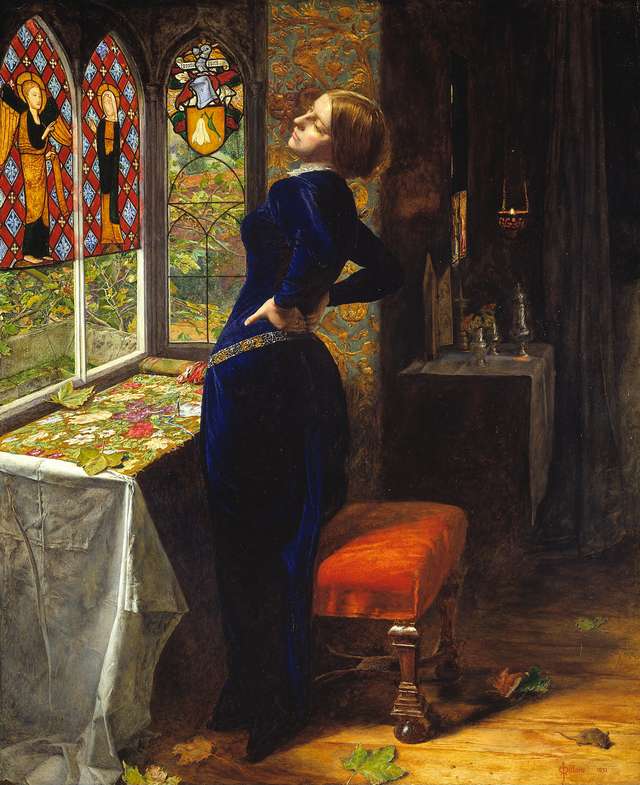
Mariana is one of the finast examples of Milais' mastery. We see his love for details in dead mouse on the floor and can find loads of symbolism in colors. Mariane is another popular fictional character in paintings of redheads.
Artists who portrayed Mariana as a redhaired woman were (from left to right) are:Arthur Hughes (1832-1915), John William Waterhouse (1849-1917) and Marie Spartali Stillman (1844-1927).
Paintings of Mariana
John William Waterhouse (1849-1917)
This famous English painter was technically not a Pre-Raphaelite (one of recent exhibitions named him 'Modern Pre-Raphaelite'), but majority of his works fall into this style, what includes his fondness of redheads and mythology themes. We have already seen his portraits of Ophelia and Mariana as red haired ladies and here a few more redheads

Miranda from The Tempest by William Shakespeare is another popular character, portrayed by Waterhouse. He decided to make a painting with her in 1875 (above) and 1916 (below), the later being one of his last works. In both cases he decided to present Miranda with reddish hair, but in different hues.
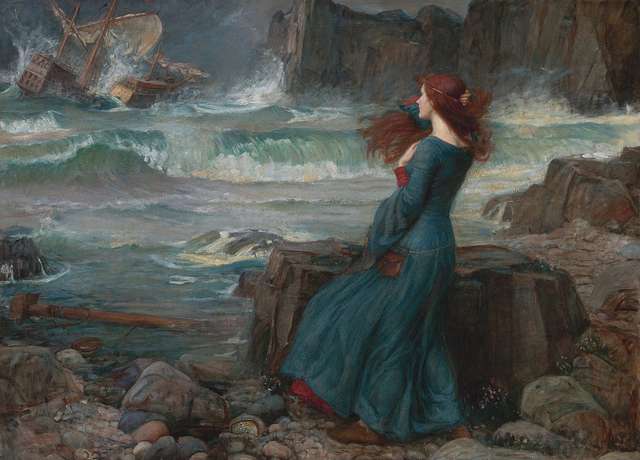
Miranda and Ophelia were not the only gingers from Shakespear's works, painted by Waterhouse. There is also Juliet, walking alongside the canal in Venice. One of the most tragic female figures is also presented with red hairstyle. The alternative name of this painting from 1898 is Blue Necklace.
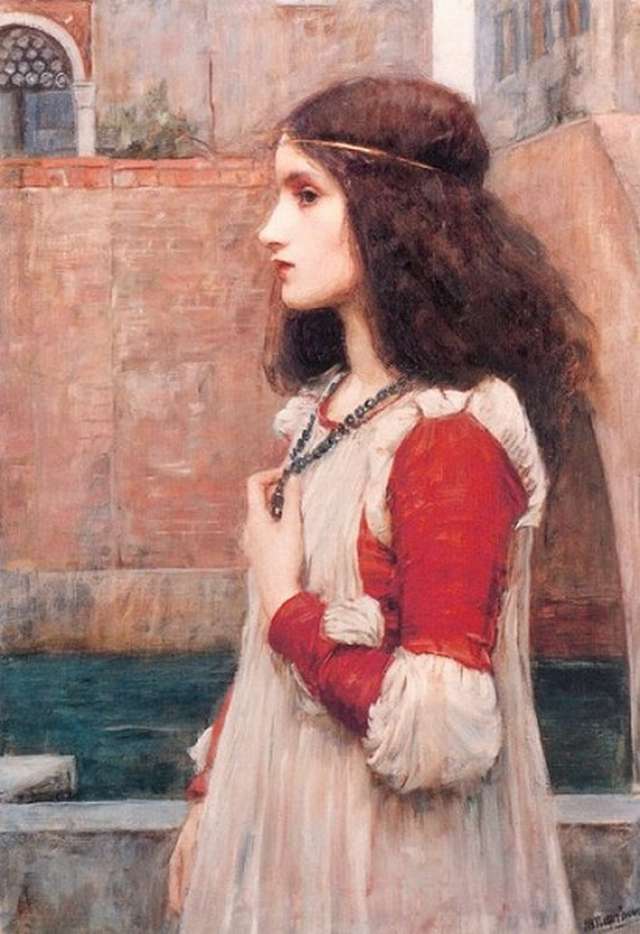
Next two paintings by John William Waterhouse were made in 1903. The first scene shows Echo and Narcissus by the pool.

And here is another fascinating character from Greek mythology - Psyche. There opens the golden box:
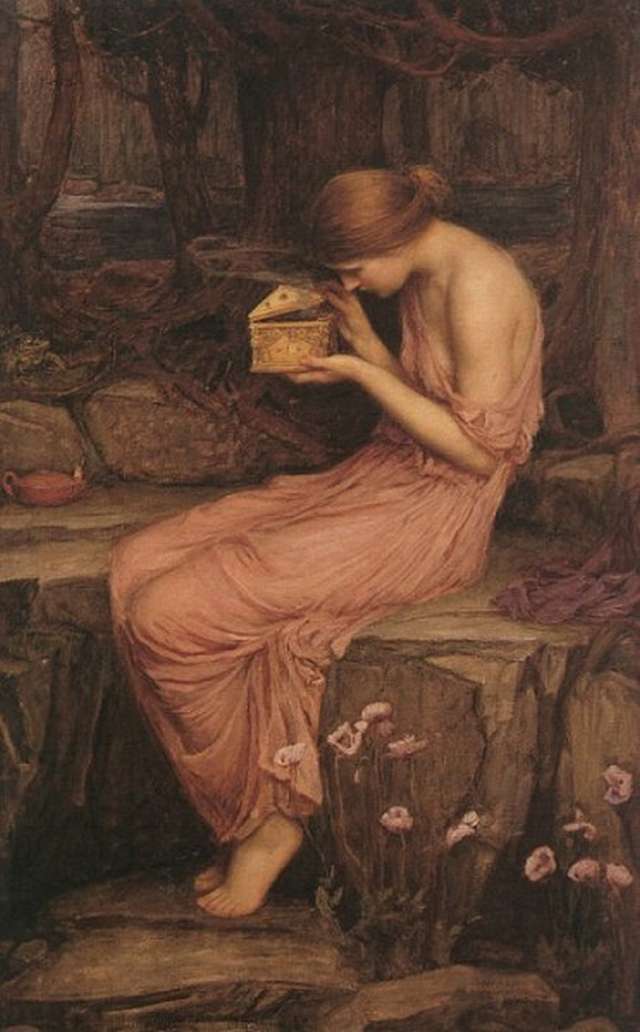
And here opens the door into Cupid's garden. This painting was made about one year later (1904).
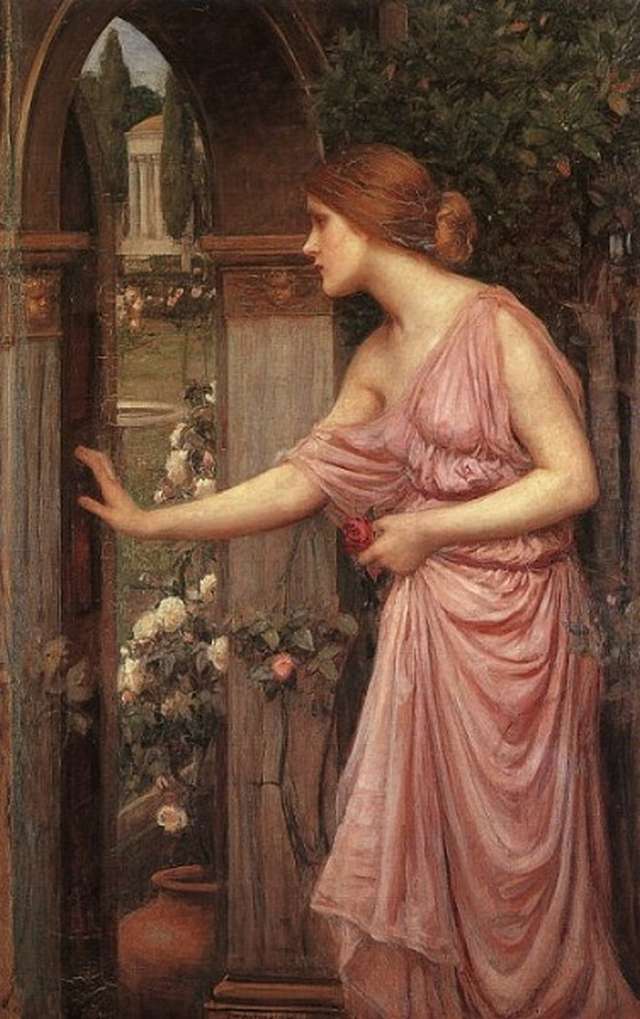
Waterhouse also decided to give red hair to Lamia, beutiful queen who turns into child-eating daemon. Nex two paintings are dated 1905 and 1909.
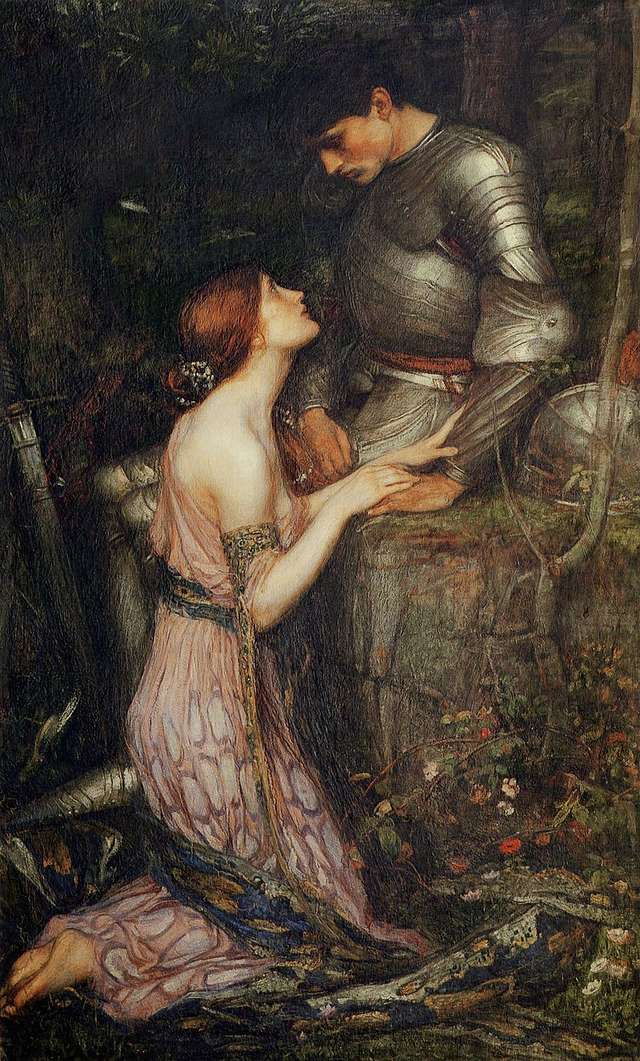
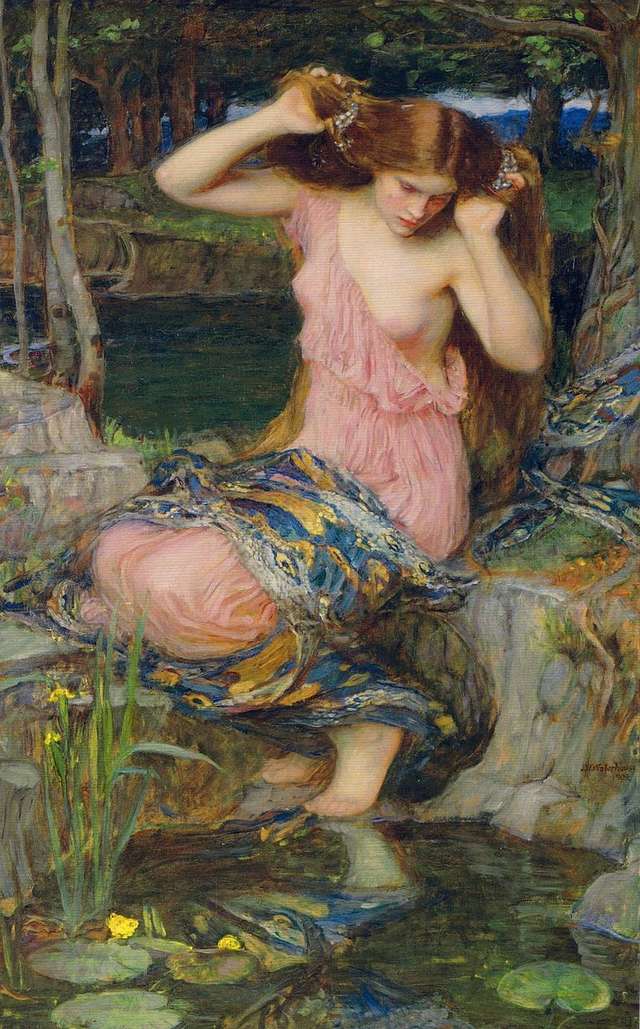
Lamia is not known in Greek mythology only. She has monstrous characteristics in other areas of Europe as well. It seems she is everywhere closely connected to water, like mermaids, another favorite subject for Waterhouse.
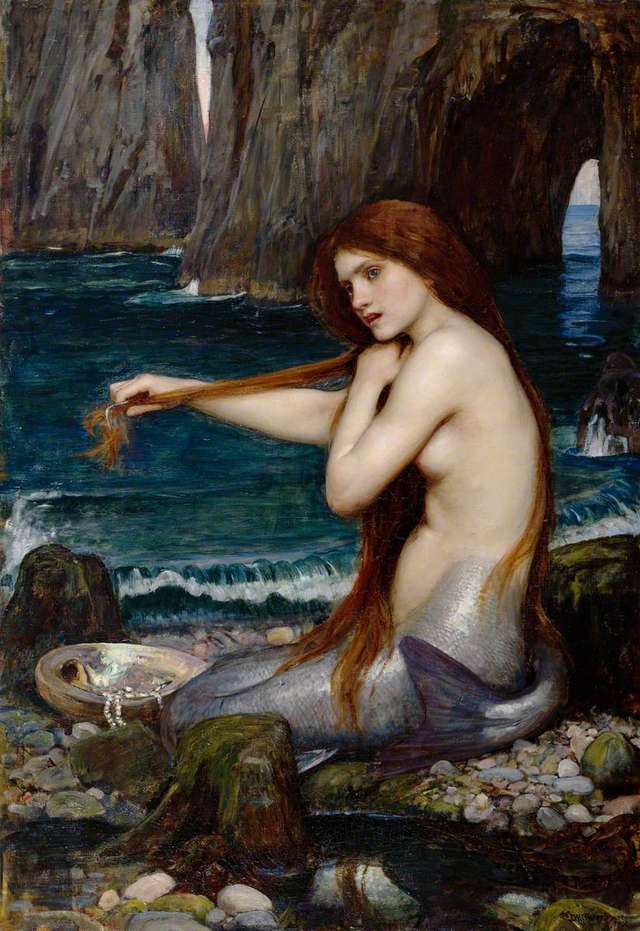
The work simply called A Mermaid is dated 1901. If you want to know more how the artist worked around the subject of water deities, visit this page about Waterhouse's paintings.
Next mythological area was Arthurian legends. Here is on eof the most famous subjects: The Lady of Shalott from 1888.

The Lady of Shalott
Lady of Shalott is a popular motif among other artists as well. Not all of them portrayed her as a redhead, but we had no trouble to find a half of dozen who did just that. Here they are (from left to right) : Henry Meynell Rheam (1859–1920) , William Maw Egley (1826–1916), John Melhuish Strudwick (1849–1937), Lancelot Speed (1860-1931), and John Atkinson Grimshaw (1836-1893). The painting in the second row is signed by Sophie Gengembre Anderson (1823-1903).
Lord Alfred Tennyson wrote the ballad about Lady of Shalott, yet this is not the only ballad which impressed painters to make beautiful masterpieces. We should mention at least one more, written by John Keats:
La Belle Dame sans Merci
Shall we start with Waterhouse again?
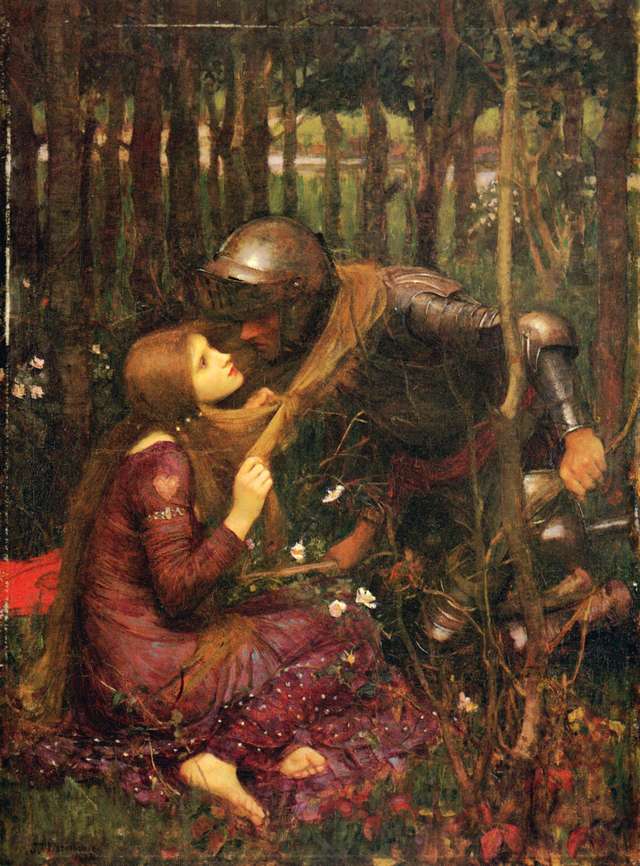
As you expected, a whole series of interpetations with more redheads on paintings follows. The artists are (from left to right): Walter Crane (1845-1915), Frank Dicksee (1853-1923), Henry Meynell Rheam (1859–1920)
Frederic Leighton (1830-1896)
Being also known as the first painter with a given peerage and still the one with the most short-lived peerage (died the day after acquiring it), this English painter managed to poses a certain level of secrecy about his private life, which fuels the imagination of art historians. Some believe he had an illegitimate child with one of his models, others imply he was more attracted to men than women. One thing is for sure. He loved color red and we can find many beautiful paintings of redheads among his works.
Clytie (below), for instance, was completed just before his death.
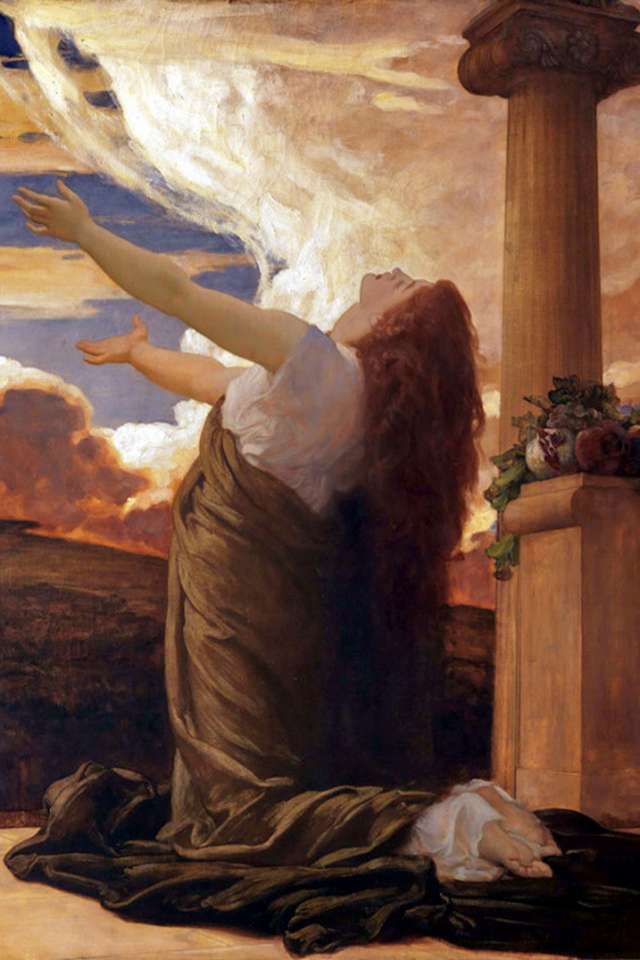
Next painting brings another interesting story. Maybe even more stories. It is a portrait of Crenaia, a nymph of Irish river Dargle. Te model in the painting is Dorothy Dene (1859-1899), a young actress from poor family, who became the artists protege and kind of celebrity, mostly thanks to his paintings of her beauty.
The original is thepart of private collection of Juan Antonio Perez Simon, a telecommunications billionaire, who's passion are paintings in Victorian style. The painting below was made in 1880, when Leighton was already 50 years old.
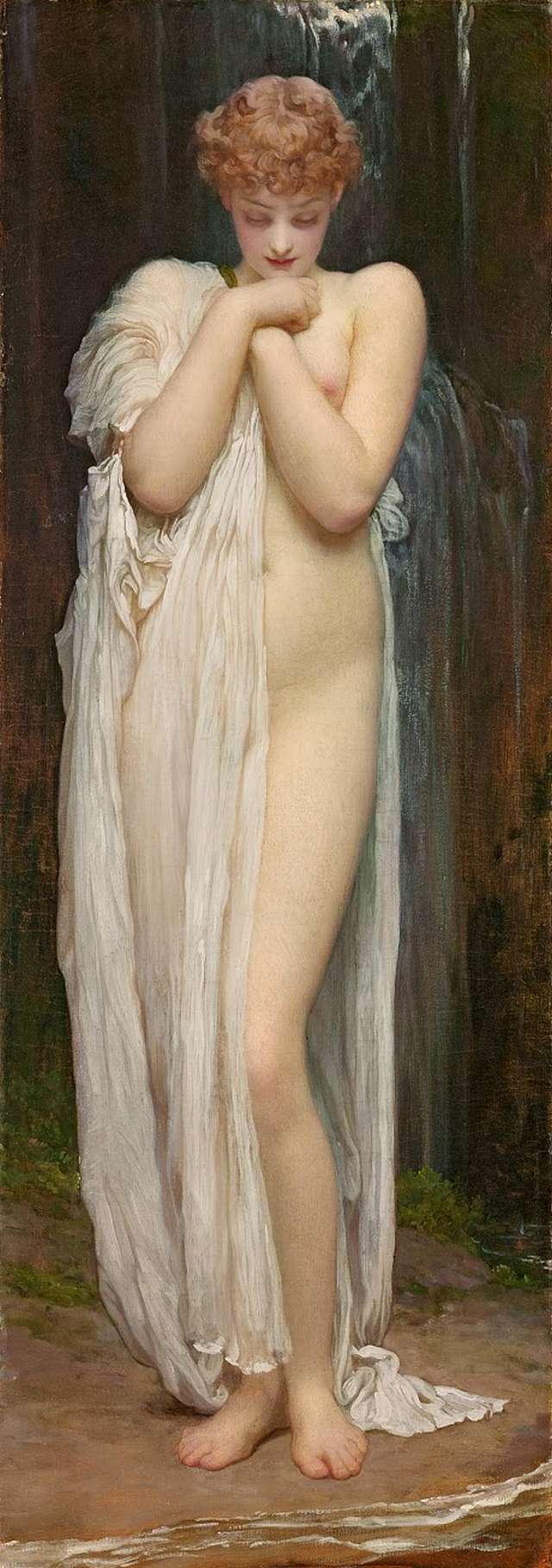
Flaming June, the painting from 1895, is now considered one of Leighton's major works, yet it went through several ups and downs in the last century. The first mystery surrounding the painting is a model for sleeping model. Before mentioned Dorothy Dene and another Leighton's favorite Marie Loyd are among most believable candidates.
The artist at first wanted to use the sleeping woman to adorn a marble bath in one of his other paintings, but soon decided to use it on its own, in well-known tradition of sleeping nymphs and naiads. He invested a lot of time to find the perfect sleeping position, full of sensuality, yet as much natural as possible. Her right shoulder caused particular trouble to him. Leighton made at least five sketches (four nudes) before even started with the painting.
While we consider the result a spectacular painting from one of the finest artists of his time, the very same work didn't intrigue much of an interest in several decades after the first exhibition. For years nobody wanted to pay even afew hundred dollars for the painting, which eventually landed in Museo de Arte de Ponce in Puerto Rico.
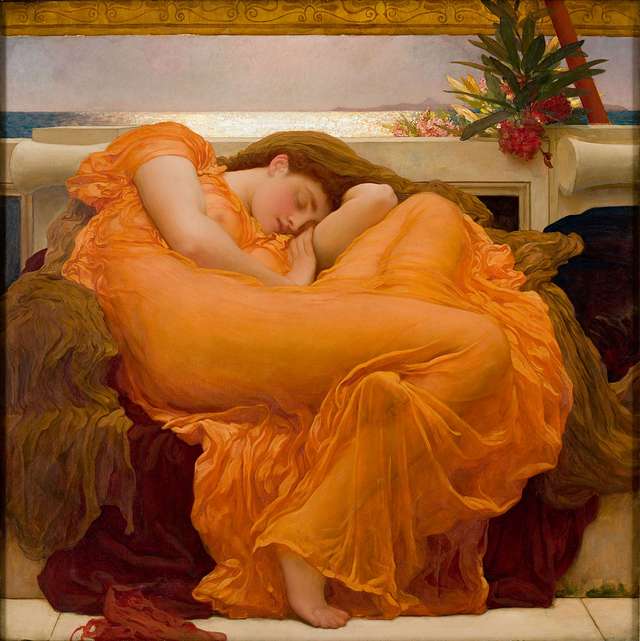
Let's finish our journey into the world of Leighton's imagination and fondness for redheads with another mythological character and one of the most notorious femmes fatales - Helen of Troy. The painting was made in 1865.

Helen of Troy
As you may expected, the lady, which caused the Troyan war and one of the finest epics Iliad, ignited numerous creative sparkes among painters all over the world. Here is a selection of the ones who decided to portray her with red hair (from left to right): Gustave Moreau (1826-1898), Jacques-Louis David (1748-1825), Walter Crane (1845-1915), Guido Reni (1575-1642) and Evelyn de Morgan (1855-1919).
By the way ... Did you know that Helen of troy was not born but hatched from an egg? Yes, you got it right, her mother Leda who was married to the king of Sparta, had an affair with Zeus (who didn't?) who seduced her in the form of the swan. Leda's activities with her husband and her divine lover produced two eggs and four children. Helen (of Troy) and Clyemnestra were her daughters, Castor an Pollux were her sons. Historians still disagree about who was the father of whom.
Anyway, here is a painting by the Andrea del Sarto (1486-1531) who saw Leda and her children as redheads. (credit)

Gaston Bussiere (1862-1928)
This simbolist and Art Nouveau painter from France, born in Cuisery, loved redheads too. One of his other passions were mythological charcaters, so we can only expect a few famous ladies from the most popular stories in our history - portrayed with red hair.
Yes, he painted Helen of Troy, also known as Beautiful Helen, as a ginger!
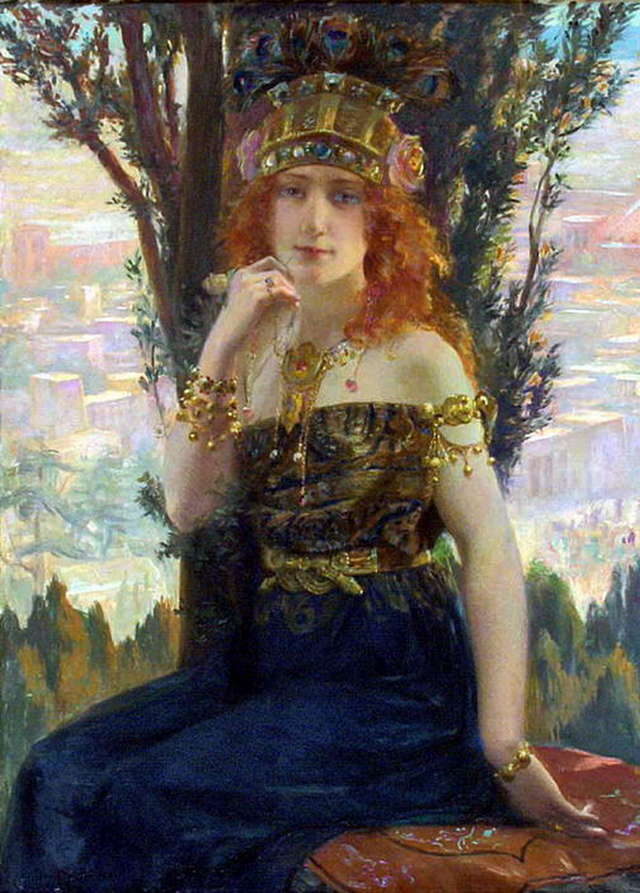
And here we have his vision of Ophelia:

In 1911 he painted this oil of Isolde, from the Arturian story of Tristan and Isolde.
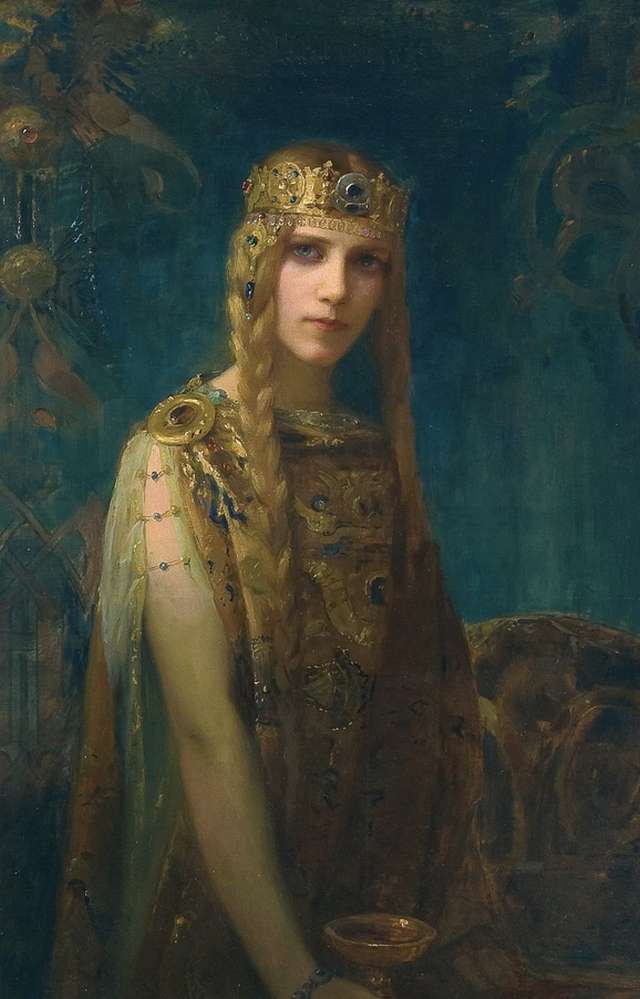
Gaston Bussiere was no stranger to the legends related to Nibelung, culminating in Wagner's The Ring of Nibelung. Bussiere's Brunhilde was a striking redhead, as we can see on the next vintage postcard from 1897.

Next interesting character is Salammbo, the protagonist of Gustave Flaubert's historical novel with the same title. Due to sensuality and violence in this novel the work became pretty controversial what probable helped making it a bestseller and helped author achieving high status.
This is how Bussiere imagined Salammbo:
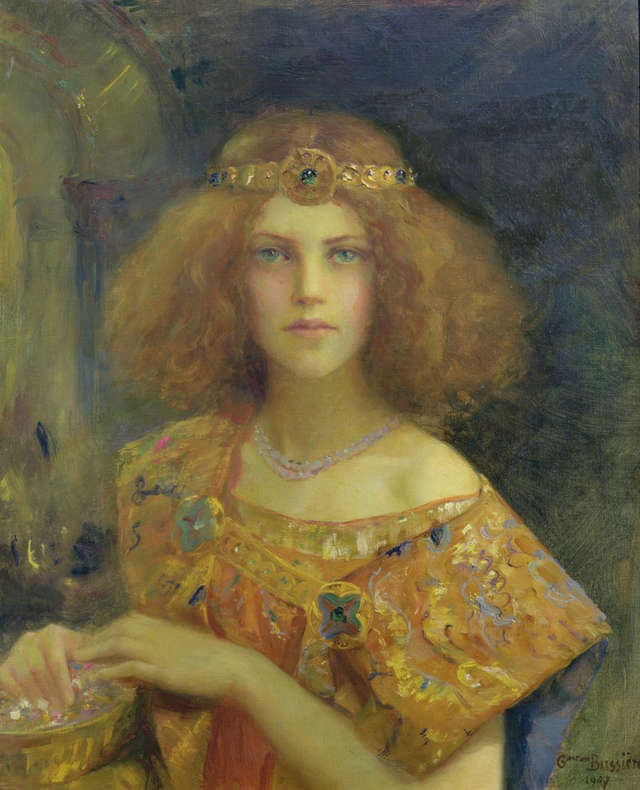
Being in France we probably can't leave without mentioning another famous redhead: Joan of Arc. Next scene shows how she was predestined for her action.
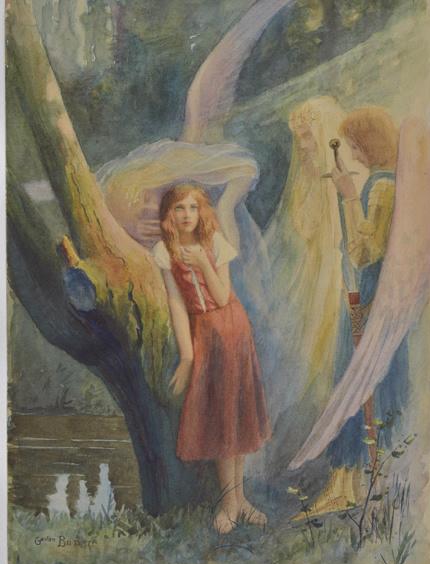
Joan of Arc
Joan of Arc, also called The Maid of Orleans (1412-1531) played so important role in the so-called Hundred Years' War (which actually lasted 116 years) she was declared a saint and French still celebrate a special holiday (every second Sunday in May) in her honor.
Authors of read-headed Joan of Arc are (from left to right): Dante Gabriel Rossetti, Jules Bastie-Lepage and Hermann Anton Stilke.
Phoebe Anna Traquair (1852-1936)
To be honest, the red color of hair wasn't popular among male painters only. Phoebe Anna Traquair is a fine example of a red-color lover. She was one of the first women who were recognized as top professional artists in Scotland. Technically she belonged to the Arts and Crafts movement and like most of its members, she contributed to numerous areas of art and design, from furniture and mural decoration to bookbinding and enamelwork, from jewelry design to book illustration. She even designed her very own gravestone.
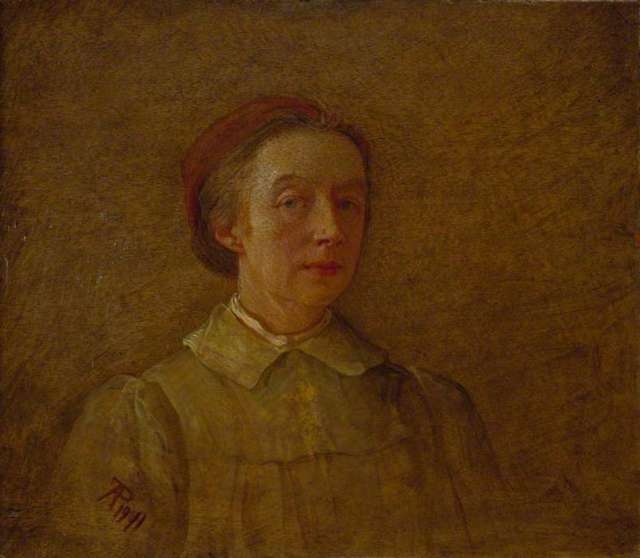
Self-portrait by Phoebe Anna Traquair
She was also associated with the Celtic Revival and Scottish Renaissance. The Pre-Raphaelites were the other major influence on her artistic development. We have already seen how popular were red-heads at Rossetti and Millais. The next paintings show her inclination to this color.
The Progress of the Soul is a four panel tapestry presenting four stages of man's life. The man in question is so androgynous it can easily represent a woman too.
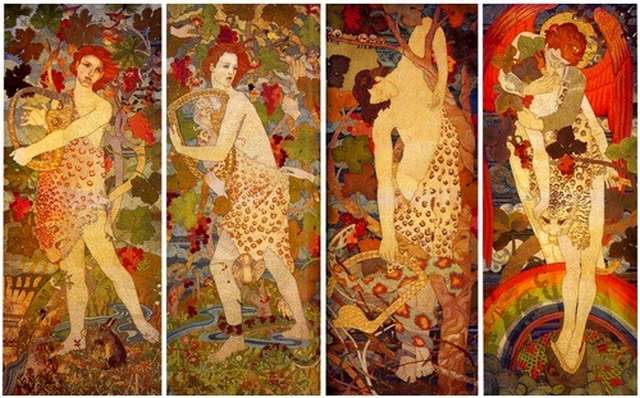
The first panel is all about playing. Life is beautiful full of colors, fruit, music, and sunshine. There's even a cute little rabbit in the scene.
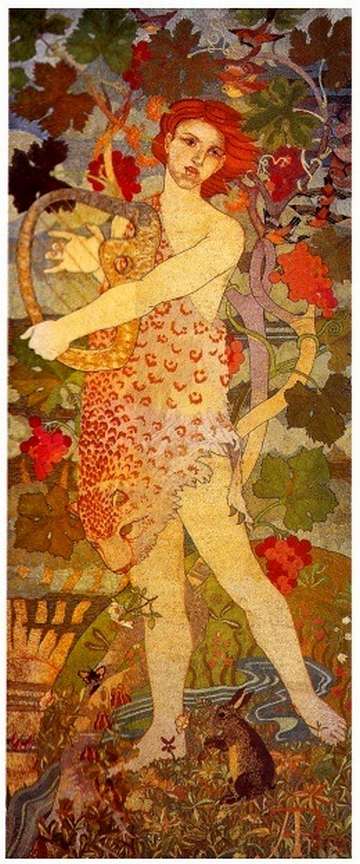
The second panel introduces worries. These are hands trying to take away the clothes, the grapes, and the lyre. A python came on the stage and a swan killed the rabbit (down left corner). Thy idyll is obviously over.

The second panel introduces worries. These are hands trying to take away the clothes, the grapes, and the lyre. A python came on the stage and a swan killed the rabbit (down leftquarter). Thy idyll is obviously over.

The third panel shows the python wrapped around the man. The man looks exhausted, maybe already dead. The lyre is still in his hands. Several birds on the branch observe the scene.
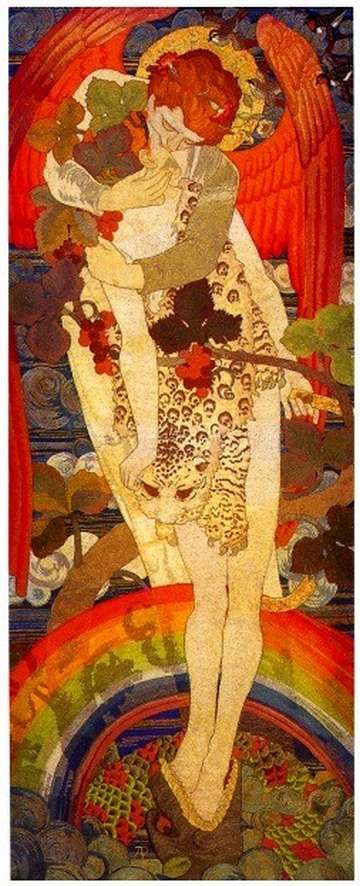
The fourth and last panel is very different. An angel is holding the man who stands on the rainbow suggesting they are both already in another world, somewhere above this one. The python stays under the rainbow.

Cupid's Darts from 1897 is an oil on canvas on board, on display at the National Trust for Scotland in Kellie Castle & Garden.
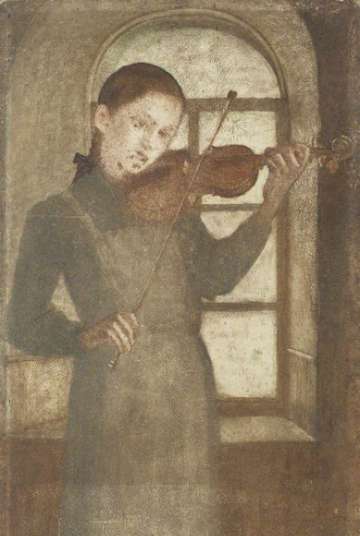
Girl Playing a Violin is an oil on panel painting from 1912. It's only 32 cm high.
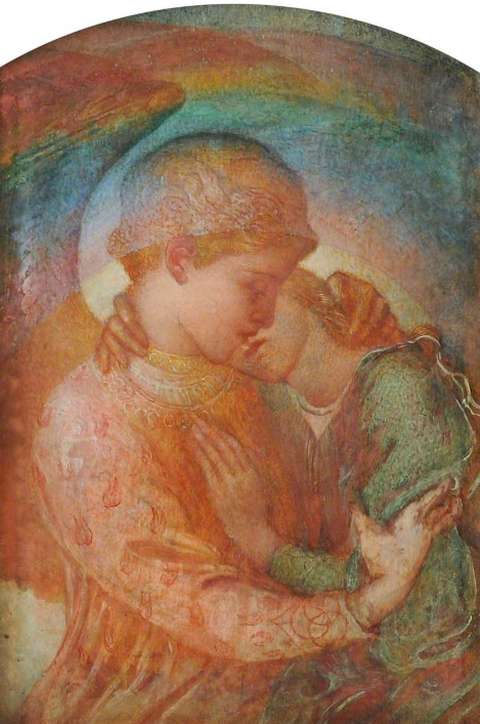
This painting is titled Reception and can be seen in Tullie House Museum and Art Gallery. It was used a s an illustration From Isles of the West to Bethlehem by Grace Warrack (1855-1932) publiseh in 1921. This was not the only illustration by Traquair for the same author.
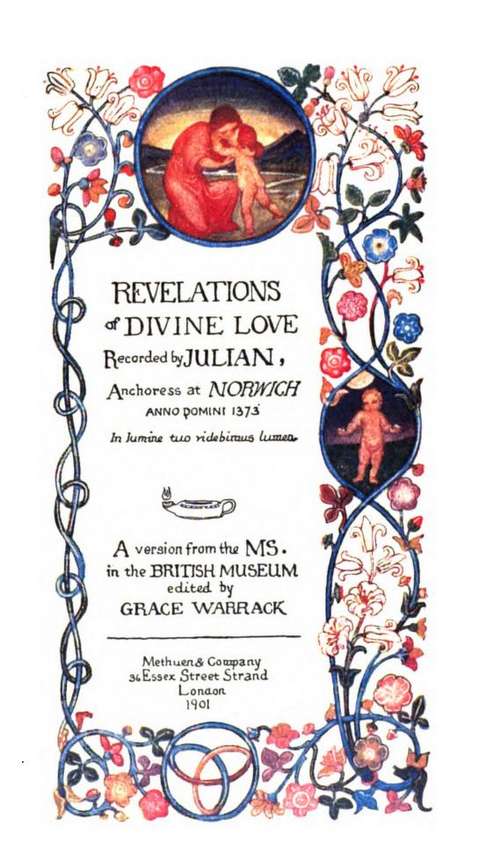
Revelations of Divine Love from 1901 was Warrack's first published book and Traquair made this title page as well. Redheads are dominating again.

This is theillumination for Elizabeth Barrett Browning's Sonnets from the Portuguese illustrated Sonnet 30.
Marianne Stokes (1855-1927)
Mrs. Stokes was very fond of red, especially after falling under the influence of the Pre-Raphaelites. Redheads were among her favorite subjects, no matter the chosen theme.
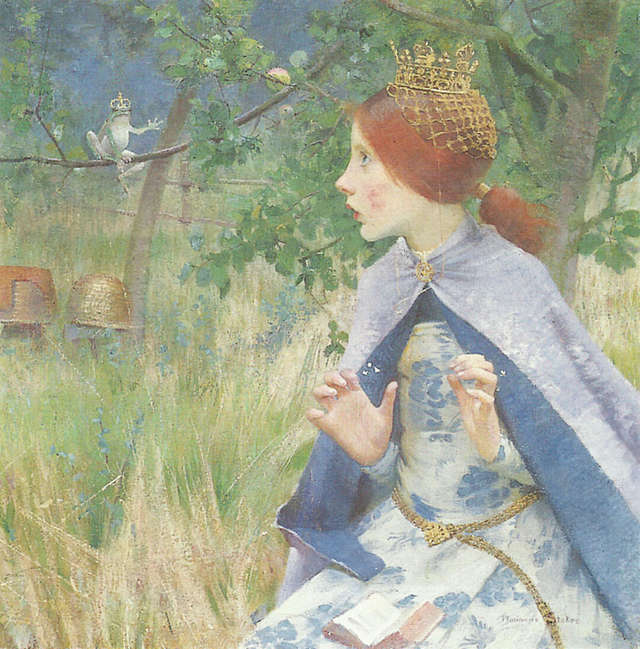
The painting from the scene of The Frog Prince (aka The Frog King) was made in 1890 with a clear impact of Impressionism. While the red color is not as intense as we'll see in the next examples, it still clearly dominates the composition.
Garlic Seller, the painting below, belongs to the book Hungary, written by her husband Adrian Stokes and published in 1809 after a series of visits to Hungary, following several exhibitions. Marianne (she made all the portraits) and Adrian (he painted landscapes) contributed 75 paintings to the book altogether!

Death and the Maiden is one of Marianne's most famous paintings. It presents the then-popular motif of death coming after her victim. It was her interpretation of Horace Vernet's The Angel of Death, painted more than half a century ago, right before Marianne was born.

It's hard to compartmentalize Marianne Stoke's style. It's obviously a mixture of several styles continuously evolving from her artistic beginnings to the very end of her life. But if we had to choose just one, Symbolism would probably win the race.

Melisande above is the tragic character from Maurice Maeterlinck's play Pelleas and Melisande,which helped to pave the success of Beckett's drama of absurdity. Please note how the red color aggressively takes all the attention of the observer
The same is true for the painting below. Tristram's Death, a finale from the famous Arthurian legend seems so ... lively?
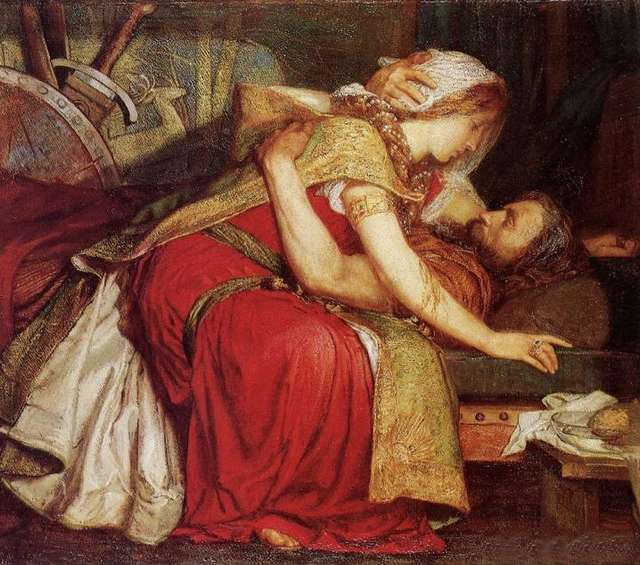
Another famous painting by Marianne Stokes is The Passing Train .
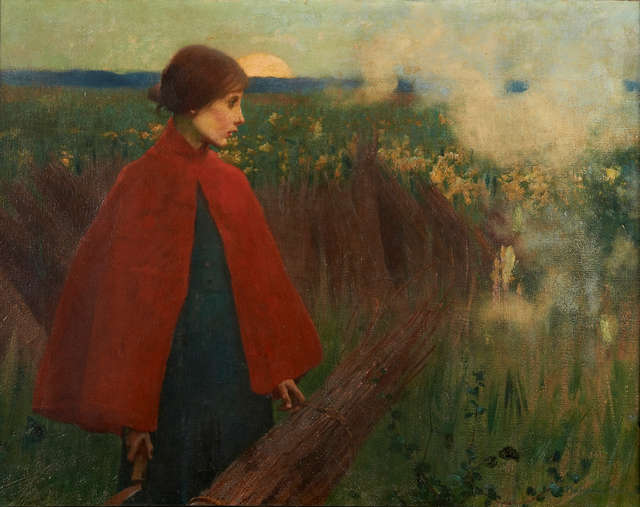
This scene was done approximately at the same time as The Frog Prince above. Even the model looks quite the same. Unfortunately, I can't find who posed for both of the paintings but she was very likely a redhead. By the way, Marianne Stokes, once described by Michael Archer as 'charming, with an unbelievable sense for colors' occasionally posed as a model too.
More about her in this article about Marianne Stokes.
John Anster Fitzgerald (1819?/1832?-1906)
John Anster Fitzgerald was more known as the Fairy Fitzgerald due to his devotion, almost obsession with fairies. Women with red-colored hair were among his additional signatures. It seems he didn't really care if he was dealing with people from his personal circle, professional models, mythical creatures, or products of momentary inspiration. Red hair was a must.
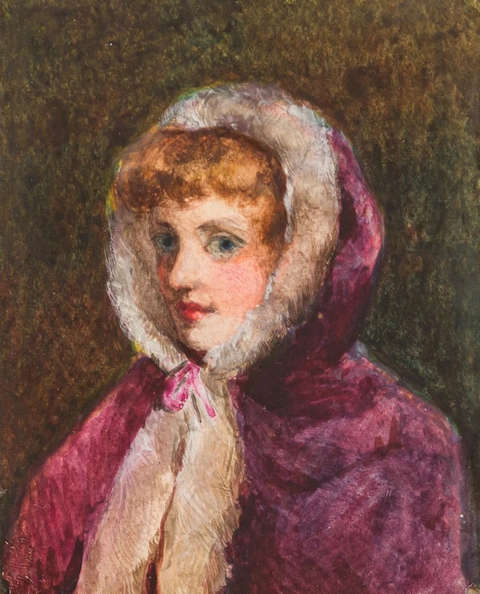
Portrait of unknown person 'From the Opera'
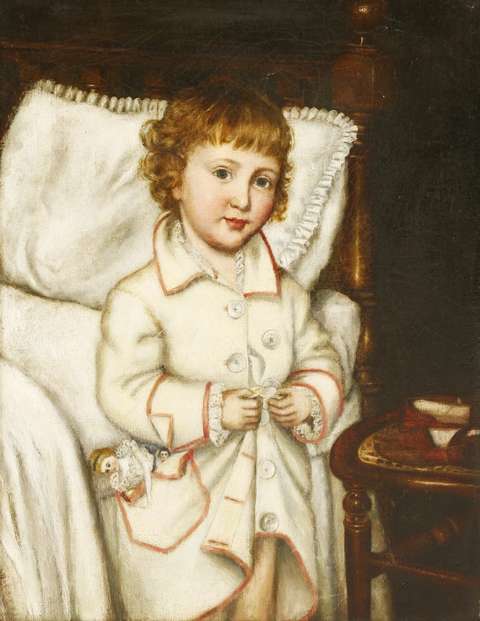
Portrait of a child with toys
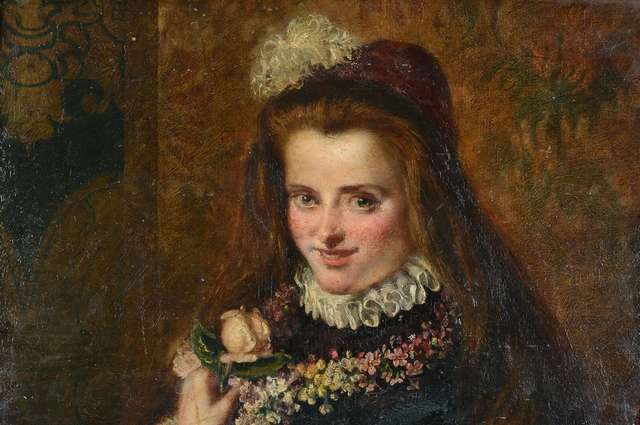
Portrait of Editha Fitzgerald
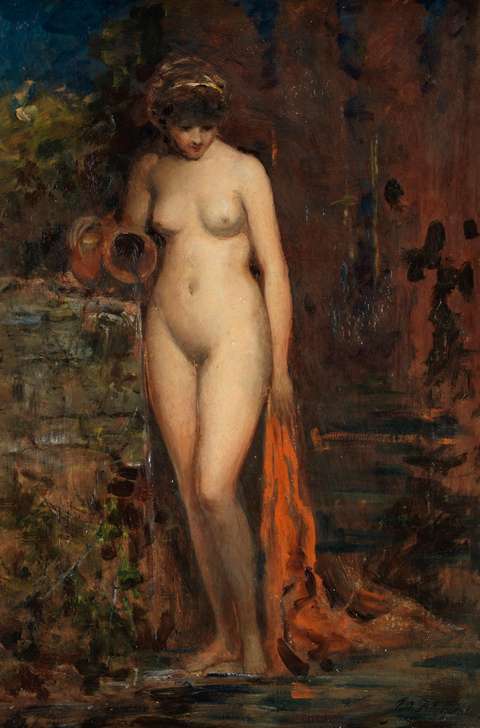
Standing Nude Bather

Study of Nude Woman
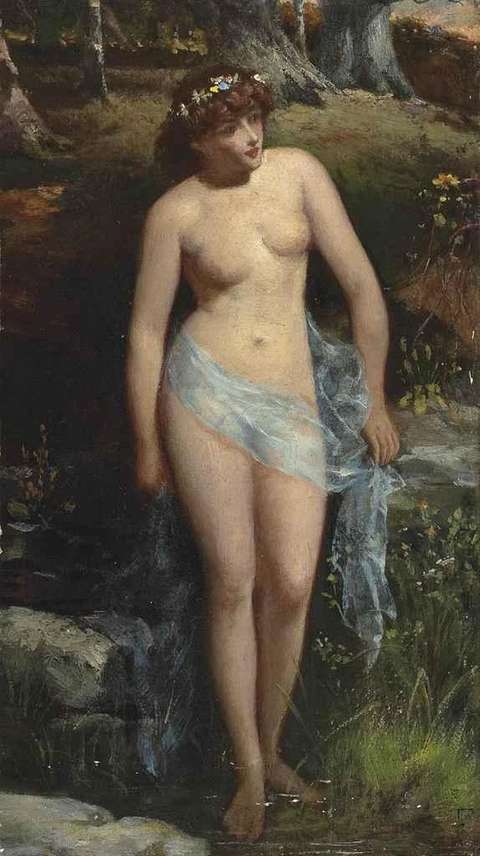
The Nymph Disturbed
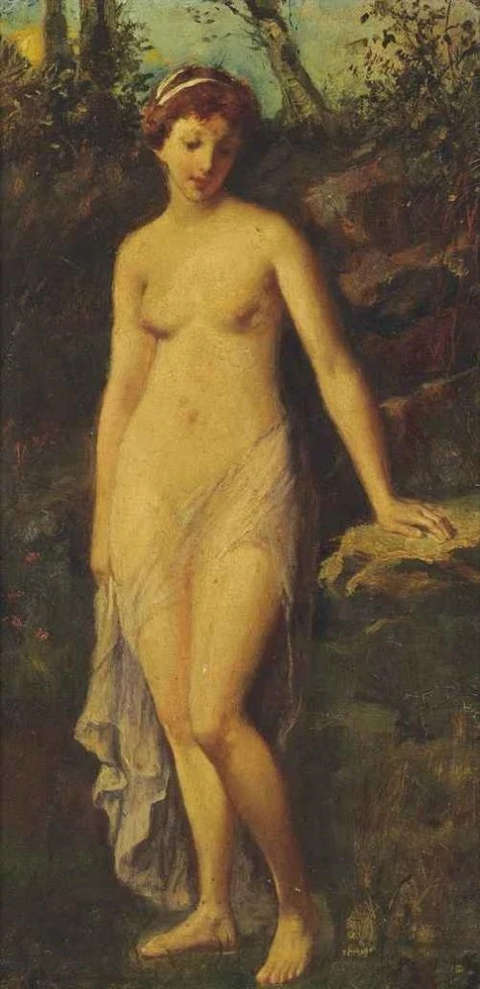
The Woodland Nymph